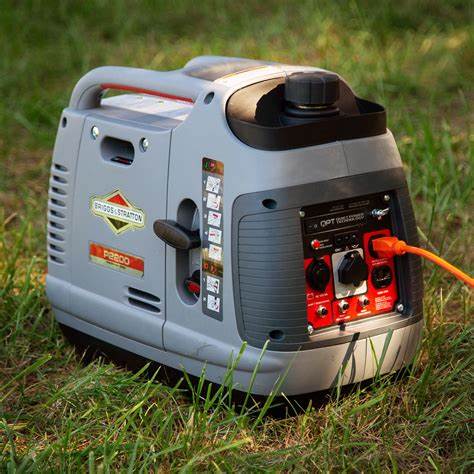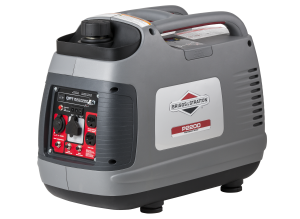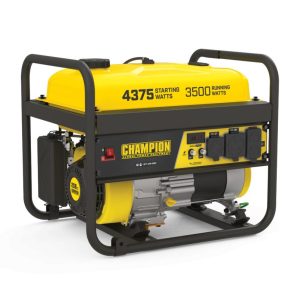Top 12 Causes of a Briggs & Stratton Generator’s Abrupt Death
When the electricity goes out, you know you can count on your generator to keep you running. It’s annoying to cope with a broken generator when you need it most during a blackout.
To help you get your generator up and running again, I have compiled a list of possible causes and solutions.
A number of issues might cause a Briggs & Stratton generator to fail to stay running, including a dirty air filter, the incorrect choke setting, a clogged fuel line, a clogged fuel filter, a dirty carburetor, a damaged gas cap, a dirty spark plug, a faulty ignition coil, insufficient engine oil, and outdated gasoline.
Table of Contents
11 Causes of a Briggs & Stratton Generator Starting Then Dying
Empty Briggs & Stratton Generator Gas Tank
To see if you’re out of gas, check the gas gauge. If a generator stops working for this reason, it’s evident. The fuel tank may have slipped your mind as you went on to other things, which is why I bring it up now.
Be sure there is no gasoline leak if you notice you are burning through gas faster than usual. As long as there is a fuel leak, the generator should not be started.
The solution is to make sure the generator is on a level surface. You should put new gas in the tank if there is none or very little left.
A Briggs & Stratton Generator Running on Outdated Fuel
There may be enough gas in the generator for it to start, but it could be old gas, which would cause it to run poorly or not at all. That’s because varnish and sticky deposits left behind by old gas choke fuel components and reduce gasoline flow.
Most gasoline contains ethanol, which attracts water, which is quite detrimental to the fuel system and the engine. This can lead to malfunctioning parts as well.
It is recommended to buy fresh gas and use it within 30 days, as gas might become bad after being stored for that long.
It’s easier to say than to do this. It’s difficult to predict when you’ll need the generator or for how long.
Sea Foam Motor Treatment is something I always put in my gas tanks to keep the gas from going bad as quickly and to prevent condensation from forming.
For optimal fuel performance, keep the following in mind:
- To operate properly, 4-cycle Briggs & Stratton generators need unleaded gasoline with an octane value of 87 or higher and no more than 10% ethanol. Don’t fill up with gas that has a high ethanol percentage.
- Get petrol within 30 days.
- Don’t store gas in the open or somewhere it might be exposed to condensation.
- Place gas cans in a cool, dry location.
- Do not stock up on more gas than you can use within a month. If you need to store additional gas, you should use a fuel stabilizer.
THE SOLUTION: Collect the used gas in a container for proper disposal. If the fuel system has to be stabilized or cleaned, try using a fuel additive in conjunction with new fuel.
Unable to Start Generator Due to Clogged Fuel Filter
An inline fuel filter is installed between the fuel lines to filter the fuel before it reaches the carburetor and the engine. The filter works to prevent engine wear and tear caused by dirt and particles.
If the filter isn’t changed regularly, it might become so clogged with dirt that no fuel can go through. When fuel pressure drops too low, the engine could die.
RESPONSE: Swap out the gasoline filter if it’s clogged up.
Briggs & Stratton Generator With a Clogged Fuel Line
A plugged fuel line is another potential source of gasoline restriction. Checking the fuel flow from each part of the fuel line when the fuel flow is stopped and started might help locate a blockage in a fuel line.
It is best to evaluate fuel flow by letting fuel flow into a container. Since fuel can’t flow uphill without a pump, it’s important to position the container below the fuel tank.
Remove the fuel line from the generator, turn off the fuel supply, and spray carburetor cleaning into the line to release the obstruction. The next step is to use compressed air to blow through the line and clear out the obstruction.
Bring the line back in. A replacement gasoline line can be acquired from a hardware store and installed if the clog cannot be cleared or if the lines are dry and cracked.
Briggs & Stratton Generator with a Filthy Carburetor
Frequently, a faulty carburetor is at blame when a Briggs & Stratton generator starts but quickly dies. Deposits can form in unused fuel, as was discussed above. Because of the deposits, the fuel jet can become clogged and the internal carburetor parts can become stuck.
The carburetor loses its ability to supply fuel to the engine in this situation, preventing the engine from shutting down.
The answer is to take apart the carburetor from a Briggs & Stratton engine. I’ve found that snapping images at key points in the process aids in putting it back together.
The residue of old fuel and fuels containing ethanol must be cleaned away, along with any sticky deposits and crusty buildups. It may be necessary to rebuild or replace your carburetor if it is too dusty or if some of its parts are broken.
A Briggs & Stratton Generator with a Clogged Air Filter
When installed, an air filter prevents debris from entering the engine. Never risk damaging the generator’s engine by not using an air filter.
It’s not enough to just use a filter; the filter needs to be clean and in good working order at all times. To put it simply, if there is a shortage of air, the generator will stop functioning.
If you utilize your generator like most homeowners, once a year is about right to change the air filter. Also, before each usage, you should inspect the filter to make sure it has been cleaned or replaced.
The following is a guide for cleaning the air filter on a Briggs & Stratton engine. If you are using a different filter or are unsure what kind of filter is in your generator, it is recommended that you refer to the manual for your specific model.
Foam air filter cleaning for Briggs & Stratton generators
- Take the filter out of its housing.
- Clean the air filter housing and cover with a damp cloth. Keep the air filter clean and make sure no dust gets in.
- The foam filter should be checked for wear and replaced if necessary.
- Cleaning the filter with soapy water and rinsing it until the water runs clear will determine its condition.
- It’s time to squeeze the filter and let it air dry.
- Foam filters don’t always need to be oiled. In that case, you should completely submerge the filter in clean motor oil. Then, press the filter to drain any remaining motor oil. Do not have it dripping with oil.
- Put the air filter in place.
- Replace the air filter cover.
Maintenance of a Briggs & Stratton paper air filter
- Take the filter out of its housing.
- Clean the air filter housing and cover with a damp cloth. Keep the air filter clean and make sure no dust gets in.
- To clean the air filter, take it out and tap it against a hard surface to loosen the dust and debris trapped inside. The paper component requires special attention to avoid tearing.
- If the air filter is damaged or has turned a dark color, you should get a new one.
- Put the air filter in place.
- Replace the air filter cover.
Briggs & Stratton Generator With the Wrong Choke Set
To get a cold engine started, you have to turn the choke lever to the “on” position, which restricts airflow and causes the gasoline to run rich. The choke needs to be released to allow air into the engine once it has warmed up.
In place of a lever, the OFF-RUN-COLD START dial on certain Briggs & Stratton models allows the choke to be opened and closed. In order to get a cold engine going, select the COLD START option. Once the engine is warmed up, it must be kept running at the run position.
If the choke isn’t set properly, the engine may stall soon after starting.
If your engine fires up but immediately dies, checking that the choke is open could be the answer. Make that the choke plate can be opened and closed easily without getting trapped.
Briggs & Stratton Generator with a Faulty Gas Cap or Fuel Tank Vent
It’s important that air may get into the fuel tank through a vent when fuel is being used. If the gasoline tank’s vent gets blocked, a vacuum will create inside the tank and prevent fuel from reaching the carburetor.
On most Briggs & Stratton generators, the fuel cap also functions as the vent for the tank’s contents. If the cap becomes plugged or damaged, it prevents air from escaping, and it must be replaced.
When the generator won’t turn on until you remove the fuel cap and let air into the tank, you know the fuel tank vent is clogged. You can try to recreate the problem by tightening the fuel cap if the generator starts and runs after you’ve loosened it.
If the generator is running well, leave it on for a while longer. If it turns off and won’t turn back on until air is introduced into the fuel tank, the vent likely has a problem.
If you notice that your gas tank is no longer venting properly, just replace the gas cap.
Briggs & Stratton Generator with a Grimy Spark Plug
A Briggs & Stratton generator can’t be started or kept running without a spark to ignite the fuel-and-air mixture.
It’s possible that the spark plug was too dirty or damaged to produce a consistent spark, notwithstanding your success in starting the generator.
Pull the plug and inspect the spark plug wires. If the spark plug’s tip is very black, the electrode is worn, or the porcelain is cracked, it needs to be replaced.
If it seems in good shape, remove the spark plug wire and clean it with a wire brush before checking the electrode gap and reattaching it. The generator may stop working because of a loose wire or a misaligned spark plug gap.
Briggs & Stratton Generator Ignition Coil Problems
Always double-check the spark plug’s condition before assuming a faulty ignition coil is to blame. It is the job of the ignition coil to supply voltage to the spark plug, allowing the engine to be started.
For obvious reasons, the engine won’t turn over if the spark plug or ignition coil is malfunctioning.
Use an ohm meter to test the ignition coil’s continuity. Change the ignition coil if you notice a break in continuity.
An Under-Oiled Briggs & Stratton Generator
It’s possible that your generator will be running for a while before it abruptly shuts off. Examine whether or not the warning light for low oil pressure is illuminated.
In order to prevent damage to the engine, most Briggs & Stratton generators are equipped with a low-oil shutoff sensor. Failure to adjust the low oil level prevents a restart.
It’s possible that the fact that it stops working is annoying. The power cutoff, though, is a welcome development here.
Lack of oil causes friction, which can cause serious engine damage if you keep driving it. It’s possible for the engine to get so hot that its components melt.
Solution: Set the generator down on a level surface and check the oil level. Take off the oil fill cap, then use a dry towel to remove the oil from the dipstick.
Simply replace the dipstick into the oil fill tube but do not tighten the lid. Take it out and check the oil level using the dipstick. Make sure it’s inside the dipstick’s full range.
If it isn’t, you should either drain some oil or add some oil to get the engine to the right level.
If you check your engine oil and find it to be at the proper level, but the low oil sensor continues to light up, you may have a defective sensor. Briggs & Stratton recommends having the generator serviced at an authorized repair facility.








